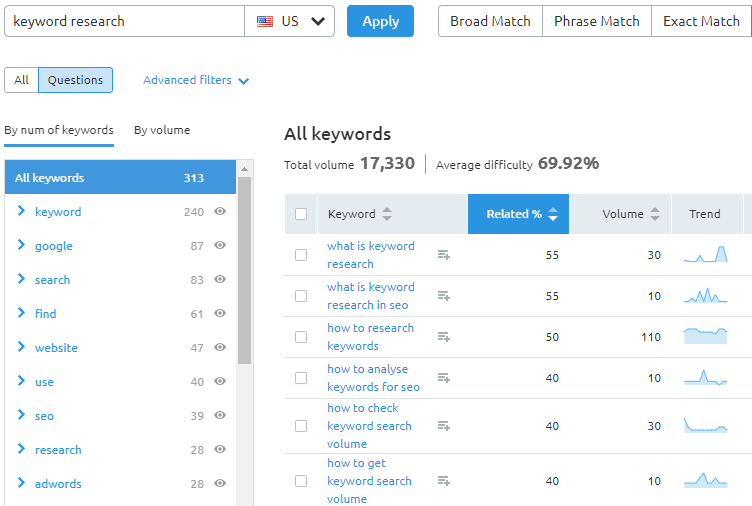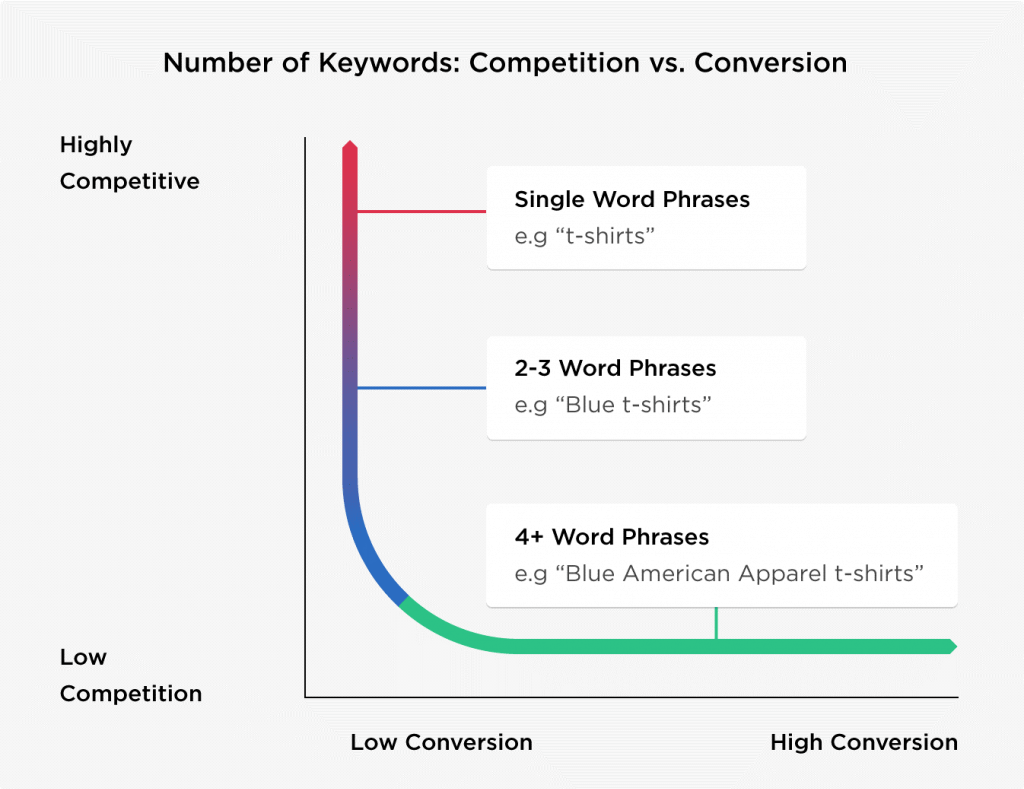If you’re serious about SEO, it’s important to understand how to research keywords and create content structured around them. Content is one of the most powerful ranking factors for Google, and if your website is a helpful resource for information-seekers, your chances of being discovered through a search engine increase.
In our marketing department, we use a variety of tools and methods to aid in keyword research, and our content team understands the importance of strategically placing keywords in information-rich content. I created this guide for anyone looking to drive more organic traffic to their site. In it, I’ll go over the basics of researching and using keywords.
It’s worth noting that before you do any keyword research, you should conduct an SEO audit to see where your website stands first. You’ll also want to put reporting in place (that will impress your boss) and can be set up automatically with Supermetrics
Acquiring backlinks can give your content an added boost, but high-quality content can actually rank and gain rich snippets even without a strong backlink profile. This is especially true if you are able to target long-tail queries and provide information that is absent from your competitors’ websites.
If you are interested in building a stronger backlink profile, I’ve also published a guide to link building that you may want to check out, but here we’ll focus on keyword research and strategy.
So, let’s get started learning about how to research keywords and use them in your content!
Tools and Tactics for Keyword Research
Keyword research is not an exact science, and your approach may change based on the website and industry. There is no best way to do keyword research that will work for every situation. However, there are certain processes that are commonly used, and a combination of these tactics should result in successful keyword research.
As you perform research, your goal should always be to find keywords relevant to your target audience. Certain keywords that are tangentially related to your subject matter may have very high volume, but you shouldn’t waste your time going after them if they would drive the wrong users to your site.
Your keyword research is likely to differ a bit based on the type of content you are creating or optimizing. While blog posts are typically targeted at those who are doing research and seeking information, the core pages of your website that describe your services are meant for users who are further down the funnel and may be ready to contact you. For this reason, blog articles will generally be the main area where you incorporate long tail keyword phrases whereas the focus keywords for core website pages are likely to be shorter phrases. We recommend identifying a three-word phrase as the focus for a webpage, and I’ll delve into that more in the section on keyword strategy for webpages.
After we go over tactics and tools, we’ll dive deeper into keyword strategy and implementation for web pages and blog articles, but first, let’s cover methods for conducting keyword research.
Using Google Search Itself
Often, when beginning keyword research, marketers start the same way a user would: by going to Google. The simple act of typing the start of a phrase into the search bar and seeing whether or not it autocompletes can give you immediate insight into whether that term is commonly used. Once you hit enter and are viewing the SERP, you’ll have even more information about your keyword.
Here are some things to look for and consider when checking a keyword on Google:
- Is the “People also ask” box showing? What kinds of questions do people ask that are related to the topic, and can you answer them?
- Would your website fit in with the sites that are ranking on the page? If not, this keyword may not be used by the right people. For instance, let’s say your website requires people to contact you for a quote, but a certain keyword turns up lots of ecommerce results like products on Amazon. You may not have a good chance at competing for a top spot on that SERP.
- Look at the individual sites that are ranking for this keyword and assess the quality of content. Do they provide sufficient information about the topic, or are there gaps that your website could address? Are people asking the question on forums and sites like Quora and Yahoo Answers but not getting answers? Forums and answer sites are also a great rabbit hole you can go down to find even more questions people are asking.
- Look at the related searches at the bottom of the SERP. Sometimes, you may find that the related searches all use different phrasing than your own search, which can guide you in finding out how people describe something.

The ideas you generate by exploring Google can guide you as you go deeper into the keyword research process and start using additional tools.
Using Organic Keyword Research Tools
Many keyword research tools for SEO essentially provide a more sophisticated way of aggregating Google’s autocompletes and related search terms.
- SEMrush: SEMrush is a powerful SEO platform with a Keyword Magic tool that can help generate ideas and show you metrics like search volume for keywords, and its sorting features let you separate out all the long tail questions. SEMrush will also show you what keywords any website is ranking for (as well as terms they are bidding on), which is great for analyzing your competitors’ success and your own success.
- UberSuggest: UberSuggest is Neil Patel’s tool that tells you information like volume and difficulty and also generates keyword ideas, similar to SEMrush. One difference is that UberSuggest is free whereas SEMrush is extremely limited without a paid account, but UberSuggest is also not as robust in terms of its features.
- Soovle: Soovle, also a free tool, is a lot less advanced than SEMrush and UberSuggest. It also shows you autocomplete phrases, but one thing that sets it apart is that it shows searches on Wikipedia, Answers.com, YouTube, Bing, and Yahoo in addition to Google.

Google also has its own official tools that can be extremely helpful when strategizing keywords: Google Search Console and Google Trends.
- Google Search Console can tell you what keywords are gaining impressions and clicks for your website as well as their click-through rate and average position. Are you getting impressions for an important phrase yet ranking on the second page and not getting clicks? You may want to create better-optimized content for this keyword. Is your website getting clicks from someone searching a question that you don’t actually answer? This may be a good topic for a new blog article, or you may want to revise the page that drives those clicks to include that answer.
- Google Trends can show you how the popularity of different search queries over time. It can also help you uncover up-and-coming keywords that may not have too much competition yet.
Performing Keyword Research Manually
While keyword research tools are great, you may find yourself in scenarios where they aren’t helping. Maybe your tools are showing 0 monthly searches for most of the queries you find, or maybe you don’t know where to start because you don’t know how customers actually describe a service. This is common in very niche industries where the terms related to the subject matter have low search volumes.
Luckily, there are other ways you can perform keyword research. Interviewing subject matter experts and customers can show you what language they use to refer to a particular product or service. It is helpful to record your interviews and put them through transcription software so you can review conversations and pick out phrases. You can also look at competitors’ websites and take notes of their phrasing.
These tactics will likely give you ideas of keywords you can enter into a tool, but don’t panic if you discover that most of them have very low search volume. This is especially common if your website’s subject matter is niche or obscure. You can’t anticipate every search, but you can make sure you are ready with content aimed at your target audience when they need it. According to Google, 15% of Google searches have never been seen before. Users describe what they want in unique ways, and search engines have to figure out what results to deliver.
Maybe you want to write an article that you know is relevant and useful to your audience and would publish it regardless of what the keyword research says. The article could add value for those who find it on your site even if it never achieves organic success, and you may be surprised at the rare long tail queries that lead users to it. Optimizing content with keywords is not the only way to only way to create value for your readers, but it is a tactic you can use to make content easier to find and therefore a more valuable asset for your organic SEO.
Remember that the keywords you find don’t necessarily need to be used verbatim on your website and blog. Google understands close variants, and you can check whether an alternative word is a close variant by searching for a term and seeing if the alternative shows up bolded in any of the results. Google can also understand when a sentence means the same thing as the less grammatically correct phrasing that users search. You should never sacrifice clarity or user experience in order to use a keyword phrase exactly. Google’s priority is to show the most helpful results to the user, and overall readability and quality play a role in how well your content performs.
Now that you know what it takes to perform keyword research, let’s move onto strategizing keywords for blog posts and then webpages.
Long Tail Keyword Strategy for Blog Posts
Keyword strategy for blog posts is typically focused around long tail phrases, and one of the goals should be to achieve rich snippets if possible. There is typically lower competition for very specific long tails questions, and you are likely to have the best luck by answering questions that other websites haven’t sufficiently addressed.
Blog posts aren’t the only type of content where you want to use long tail keyword phrases. Long form resource guides on your website can be extremely valuable content pieces that are structured around answering questions your target audience asks. Creating a spreadsheet that lays out all your planned content topics is helpful for staying organized as well as ensuring that each article or resource has a unique keyword focus.
When writing a blog article or resource piece, use long tail phrases as headers, and try to structure articles so that the outline of the article can be understood by reading the headers. This is mainly helpful for the user, but keeping this tip in mind makes writers more likely to use headers that are more specific and keyword-rich. You should also reinforce keywords and their variants in your paragraph content.
How to Get Featured Snippets for Your Site
For the best chance of getting a rich snippet on Google, answer questions directly with either 2-3 sentences or bulleted lists that immediately follow the header tag. You can always expand on your answer, but be direct first.
According to a study published by Moz, the average length of a featured snippet is 45 words and 293 characters. The average list contains 4.2 items.
Is there schema markup for rich snippets?
While John Mueller of Google has stated that there is no specific markup that will ensure a rich snippet, he has also said that it is easy for Google to pull information from tables. When looking at sites that have rich snippets, it’s not uncommon to see tables.
Tables may seem like an outdated page feature, but they are actually helpful for organizing data. There are also websites that do use markup and get rich snippets that make it look like the markup helped. For instance, using list schema makes it possible for Google to view your numbered headers as a list even if there is paragraph content between each item.
How to Strategize Keywords for Your Core Website Pages
The keyword focus for a webpage (such as a page highlighting a service offering) is unlikely to be a long tail phrase. However, you want to optimize the page around a focus keyword that has enough specificity and the right commercial intent. Three-word phrases with subject, context, and intent typically work best. That doesn’t mean all your focus keywords will be three-word phrases, but it’s a good rule of thumb for ensuring you are not trying to target a phrase that is too competitive and general.
Let’s break down what subject, context, and intent mean using the example of a company that supplies eyelash glue to product manufacturers.
- The subject is a noun and the most general part of the phrase. Ranking for a one-word phrase is extremely challenging, and there are so many things someone could mean when they’re searching for just one word. For instance, instead of looking for a company that sells glue, they could be looking for a definition of the word glue. The word “glue” on its own also does not specify the type of glue. It is risky to use single-word keywords in Google Ads for the same reason.
- The context is typically an adjective that adds a little more specificity to the phrase. “Eyelash glue” is more precise than just “glue.” However, it is not clear that someone searching “eyelash glue” is looking for a distributor that supplies wholesale products to businesses. They could be a consumer who just wants to buy eyelash glue for personal use.
- The intent is the most important part of the phrase. “Eyelash glue distributor” captures what the business really does and is more likely to be searched by people who may convert. Words like supplier, distributor, and wholesale can help the business optimize their site for the right audience.
This concept works equally well for defining keywords to use in your Google Ads campaigns. Your organic strategy and paid advertising strategy should be aligned so that you don’t need to rely entirely on ads for certain keywords as you grow pages organically. Of course, when you are deciding which keywords to spend your budget on, you may want to be more selective about the phrases you target. With paid advertising, you generally want to attract people who are ready to contact you or make a purchase. With your organic strategy, you have more flexibility to target users who are currently at the top of the funnel.
Your focus keyword and its variants should appear in your title tag and H1 and should be reinforced in body content and H2s throughout the page.

Making a Keyword Map
Remember that you want to take the structure of your entire website into account when determining the keyword focus for each page. You can use a spreadsheet to create a keyword map that shows the focus and supporting keywords for each page. Consider whether each page has a strong focus that is unique from the other pages. You don’t want your content to become repetitive. Every page should offer value, and you don’t want to dilute the strength of your keyword optimization efforts by having multiple pages littered with content that is too similar.
Your website should be structured first around what makes sense to the user, which may mean choosing to have pages that don’t directly support your keyword goals, but SEO should always be on your mind. If you have multiple pages about the same topic with the same (or similar) focus keywords, combining them into one thorough, focused page may make for overall stronger content and superior SEO.
Should long tail keywords be used on core website pages?
While the focus keyword for a webpage about a service may not be a long tail, you do have the option of using long tails as supporting keywords. You can address questions users might have about the service and to add more content to the page without writing fluff. We typically recommend a minimum of 500 words per page. There are certainly exceptions to this rule, such as contact us pages or any page where content does not make sense for user experience. However, if you don’t have at least 500 words to say about a topic without writing fluff or repeating content, you may want to consider whether the page needs to exist at all.
Well-optimized blog posts frequently grab rich snippets, but it’s also possible to gain rich snippets for your website pages. Getting a rich snippet that goes straight to a website page may increase the chance of a conversion because people who land on your blog must then navigate to your site to learn more about a service, which they may or may not do.
Working With an SEO Agency to Optimize Your Site for Keywords
Hopefully, you feel confident in your ability to find and use keywords after reading this article. However, we know firsthand how granular the keyword research process can get, and it does require a substantial time investment. High-quality content typically comes from the efforts of writers who are well-versed in SEO. While some business owners and marketing managers are able to tackle it themselves, keyword strategy and implementation often require a little outside help. After all, it’s a full time job!
If you’re looking for assistance with your business’s SEO, Miles IT is a marketing agency that can work with you to find relevant keywords and create effective content. Contact us to talk to an expert about your business goals and what you need from a marketing partner.


